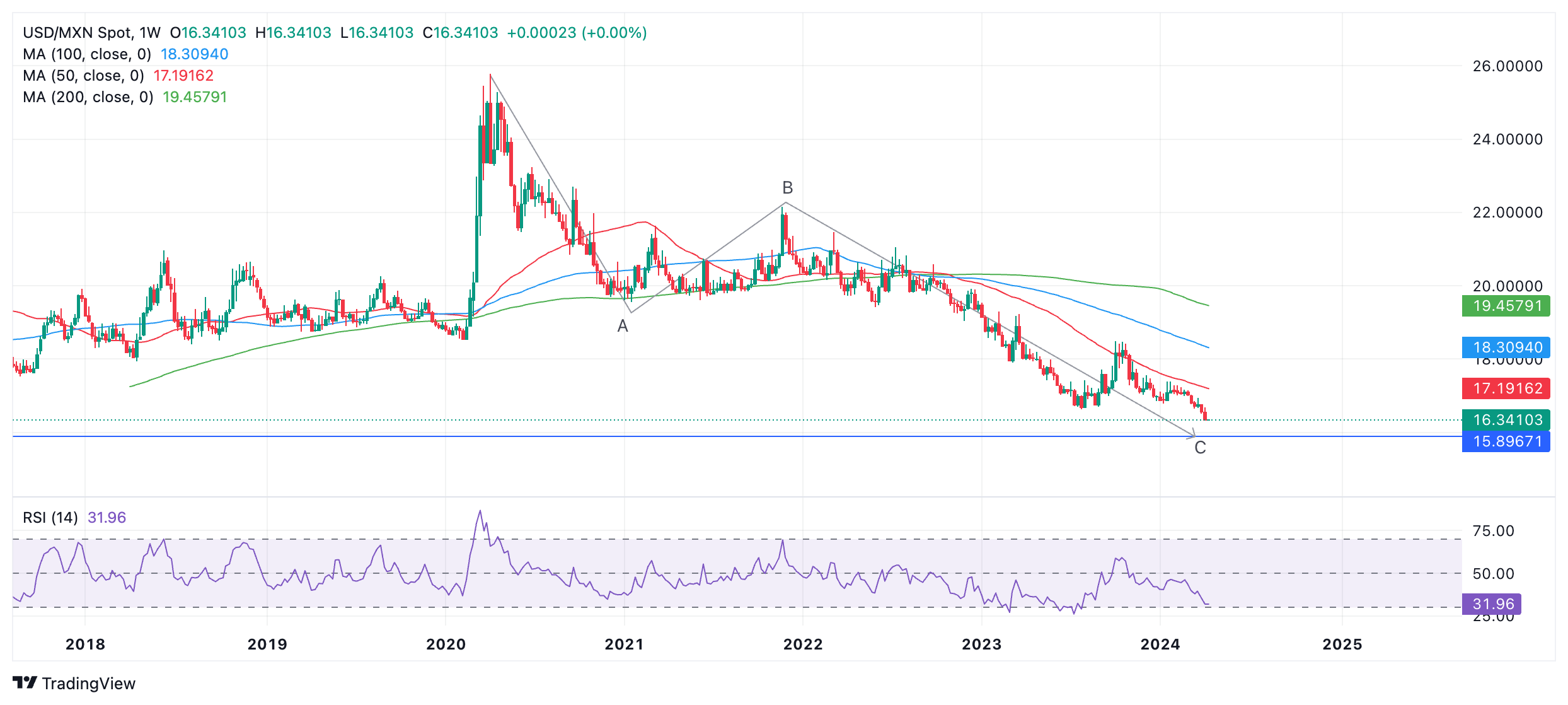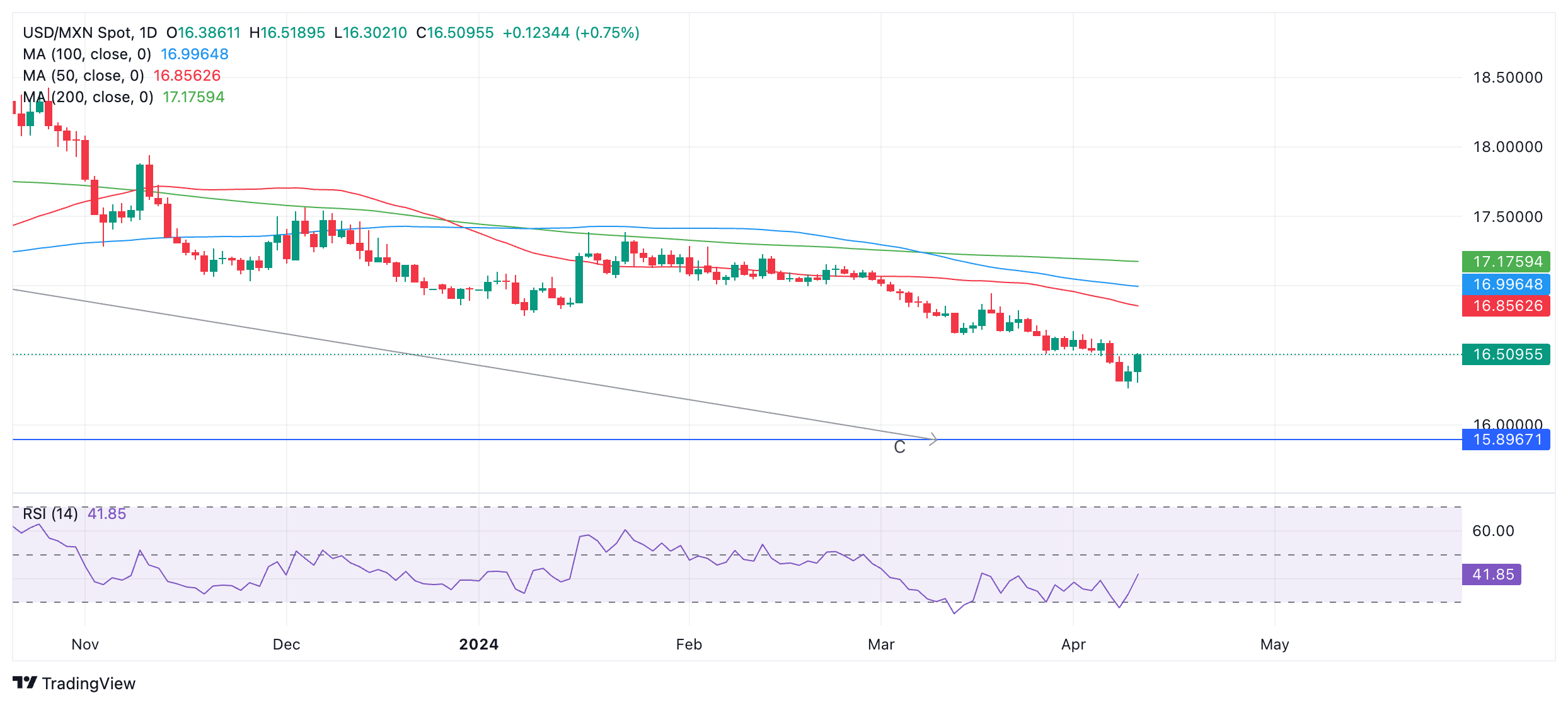- The Mexican Peso declines against the US Dollar after US inflation data for March beats expectations.
- The slowdown in price pressures was not substantial enough to change the overall outlook for monetary policy.
- Interest rates, a key FX driver, are likely to remain elevated in Mexico, supporting the Peso going forward.
The Mexican Peso (MXN) is trading lower against the US Dollar (USD), in the 16.50s, on Wednesday, after the release of hotter-than-expected US Consumer Price Index (CPI) data for March.
The data showed inflation rose higher than expected in March. It lowers the probability that the US Federal Reserve (Fed) will implement an early interest-rate cut.
With interest rates expected to remain higher for longer the US Dollar (USD) gains a boost, as higher interest rates attract greater inflows of foreign capital.
Mexican Peso declines versus USD after US CPI data
USD/MXN is seeing volatility after the release of US CPI data which deviated significantly from expectations.
Data from the US Bureau of Labor Statistics showed prices in the US rose by 3.5% year-on-year in March when a 3.4% rise had been estimated. This comes after the 3.2% rise YoY in February.
CPI for core goods, which excludes volatile food and energy prices, rose by 3.8% YoY against 3.7% expected and 3.8% previous.
Both inflation metrics rose by 0.4% on a monthly basis in March, beating the 0.3% estimated.
The hotter-than-forecast inflation keeps price pressures well above the Federal Reserve’s (Fed) 2.0% target. It makes it even less likely the Fed will bring down interest rates from their current 5.5% level in June as had been predicted.
Mexican Peso continues rising on interest rate divergence
Despite the expectations interest rates will remain higher for longer in the US, the Mexican Peso has broadly developed a long-term uptrend against most counterparts on the back of relatively high interest rates in Mexico, which help attract inflows of foreign capital.
Although the Banxico cut its Overnight Interbank Target Rate from 11.25% to 11.00% in March, it did so without committing to further rate cuts.
The move came on the back of lower trending inflation, however, the meeting minutes revealed the view that the balance of risks continue tilting in favor of inflation remaining stubbornly high going forward. This will likely require the Banxico to keep interest rates at their relatively high level, continuing to underpin the MXN.
This week sees the release of Industrial Production and Retail Sales data on Thursday and Friday respectively, for Mexico. Neither are in themselves likely to move the Mexican Peso, but they will provide more intelligence on the performance of the economy.
High-than-expected macroeconomic data will likely buttress the Mexican Peso. Banxico said that despite higher interest rates, the economy continues showing a high degree of “dynamism” and resilience and data that backs up that view. This will probably mean the central bank keeps interest rates at their relatively elevated level for longer.
Technical Analysis: USD/MXN shows signs of reversal
USD/MXN is in a long-term downtrend, however, the entrenched trend is showing increasing signs of fatigue.
The pair is probably unfolding a large three-wave price pattern called a Measured Move. These patterns are composed of an A, B, and C wave, with wave C extending to a similar length to wave A, or a Fibonacci 0.618 ratio of A.
USD/MXN Weekly Chart
If this is the case, price has almost reached the point at which C will equal A, calculated at 15.89.
It has also by now surpassed the conservative target for the end of C at the 0.618 Fibonacci extension of A (at 18.24).
Once the pattern is complete the market usually reverses or undergoes a substantial correction.
The Relative Strength Index (RSI) is converging acutely with price – a sign the downtrend could be losing momentum. In 2024, USD/MXN has pushed lower than the 2023 lows but the RSI has not followed suit. This non-correlation is a bullish indication. It could lead to a correction higher eventually.
USD/MXN Daily Chart
The daily chart shows more recent activity in greater detail. A feature worth noting is the RSI, which has risen out of oversold territory. This recommends that short-holders trading over an intermediate time frame (3-6 months) should close their short bets and open longs.
Taken together with the bullish convergence on the weekly chart and the strong bullish recent price activity this may signal USD/MXN is about to begin a correction higher.
Mexican Peso FAQs
The Mexican Peso (MXN) is the most traded currency among its Latin American peers. Its value is broadly determined by the performance of the Mexican economy, the country’s central bank’s policy, the amount of foreign investment in the country and even the levels of remittances sent by Mexicans who live abroad, particularly in the United States. Geopolitical trends can also move MXN: for example, the process of nearshoring – or the decision by some firms to relocate manufacturing capacity and supply chains closer to their home countries – is also seen as a catalyst for the Mexican currency as the country is considered a key manufacturing hub in the American continent. Another catalyst for MXN is Oil prices as Mexico is a key exporter of the commodity.
The main objective of Mexico’s central bank, also known as Banxico, is to maintain inflation at low and stable levels (at or close to its target of 3%, the midpoint in a tolerance band of between 2% and 4%). To this end, the bank sets an appropriate level of interest rates. When inflation is too high, Banxico will attempt to tame it by raising interest rates, making it more expensive for households and businesses to borrow money, thus cooling demand and the overall economy. Higher interest rates are generally positive for the Mexican Peso (MXN) as they lead to higher yields, making the country a more attractive place for investors. On the contrary, lower interest rates tend to weaken MXN.
Macroeconomic data releases are key to assess the state of the economy and can have an impact on the Mexican Peso (MXN) valuation. A strong Mexican economy, based on high economic growth, low unemployment and high confidence is good for MXN. Not only does it attract more foreign investment but it may encourage the Bank of Mexico (Banxico) to increase interest rates, particularly if this strength comes together with elevated inflation. However, if economic data is weak, MXN is likely to depreciate.
As an emerging-market currency, the Mexican Peso (MXN) tends to strive during risk-on periods, or when investors perceive that broader market risks are low and thus are eager to engage with investments that carry a higher risk. Conversely, MXN tends to weaken at times of market turbulence or economic uncertainty as investors tend to sell higher-risk assets and flee to the more-stable safe havens.
Information on these pages contains forward-looking statements that involve risks and uncertainties. Markets and instruments profiled on this page are for informational purposes only and should not in any way come across as a recommendation to buy or sell in these assets. You should do your own thorough research before making any investment decisions. FXStreet does not in any way guarantee that this information is free from mistakes, errors, or material misstatements. It also does not guarantee that this information is of a timely nature. Investing in Open Markets involves a great deal of risk, including the loss of all or a portion of your investment, as well as emotional distress. All risks, losses and costs associated with investing, including total loss of principal, are your responsibility. The views and opinions expressed in this article are those of the authors and do not necessarily reflect the official policy or position of FXStreet nor its advertisers. The author will not be held responsible for information that is found at the end of links posted on this page.
If not otherwise explicitly mentioned in the body of the article, at the time of writing, the author has no position in any stock mentioned in this article and no business relationship with any company mentioned. The author has not received compensation for writing this article, other than from FXStreet.
FXStreet and the author do not provide personalized recommendations. The author makes no representations as to the accuracy, completeness, or suitability of this information. FXStreet and the author will not be liable for any errors, omissions or any losses, injuries or damages arising from this information and its display or use. Errors and omissions excepted.
The author and FXStreet are not registered investment advisors and nothing in this article is intended to be investment advice.
Recommended content
Editors’ Picks

EUR/USD accelerates losses to 1.0930 on stronger Dollar
The US Dollar's recovery regains extra impulse sending the US Dollar Index to fresh highs and relegating EUR/USD to navigate the area of daily troughs around 1.0930 in the latter part of Friday's session.

GBP/USD plummets to four-week lows near 1.2850
The US Dollar's rebound keep gathering steam and now sends GBP/USD to the area of multi-week lows in the 1.2850 region amid the broad-based pullback in the risk-associated universe.

Gold trades on the back foot, flirts with $3,000
Gold prices are accelerating their daily decline, steadily approaching the critical $3,000 per troy ounce mark as the Greenback's rebound gains extra momentum and US yields tighten their retracement.

Can Maker break $1,450 hurdle as whales launch buying spree?
Maker holds steadily above $1,250 support as a whale scoops $1.21 million worth of MKR. Addresses with a 100k to 1 million MKR balance now account for 24.27% of Maker’s total supply. Maker battles a bear flag pattern as bulls gather for an epic weekend move.

Strategic implications of “Liberation Day”
Liberation Day in the United States came with extremely protectionist and inward-looking tariff policy aimed at just about all U.S. trading partners. In this report, we outline some of the more strategic implications of Liberation Day and developments we will be paying close attention to going forward.

The Best brokers to trade EUR/USD
SPONSORED Discover the top brokers for trading EUR/USD in 2025. Our list features brokers with competitive spreads, fast execution, and powerful platforms. Whether you're a beginner or an expert, find the right partner to navigate the dynamic Forex market.





